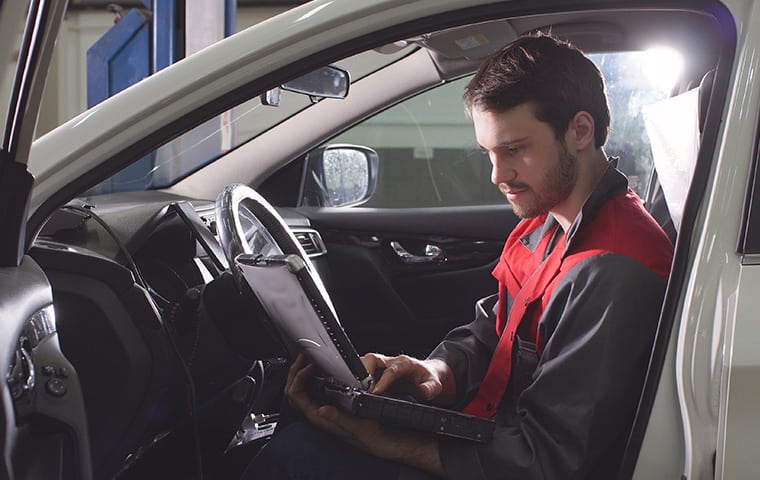Introduction
Public and private transportation have seen colossal advancement thanks to smart traffic technology, resulting in improved efficiency and safer roads. In fact, a recent survey found that 62% of local officials believe connected vehicles will result in fewer accidents.
In this article, we’ll discuss what vehicle to infrastructure communication or V2I is, the benefits of this technology, and the common role it plays in transportation.
What is Vehicle-to-Infrastructure Communication?
Vehicle-to-Infrastructure (V2I) communication is a communication model that exchanges information between vehicles and the highway system infrastructure. Infrastructure components include road signs, lane markings, traffic lights, and other smart road infrastructure connected via wireless connection.
All vehicles may connect to this communication source, such as cars, buses, trucks, and other commercial vehicles. Infrastructure communication aims to support traffic management and work zones, reduce collisions, and improve road safety.
Common Vehicle-to-Infrastructure Technologies
The V2I concept has only been around since 2015. However, here a few of the common V2I technologies that have already been released for public consumption.
Smart Parking
Have you ever seen red or green lights hanging above parking stalls in parking structures or lots? That is the result of Vehicle-to-Infrastructure communication.
Smart parking indicates which parking spots are available or taken, saving drivers time from circling the lot. Attendants can also track the occupancy of their lot much easier. This technology has already been implemented in countries like the United States, U.K, Australia, and New Zealand.
Smart parking helps enhance parking management, improve the parking experience for drivers, and streamline parking payment processes. You may find these parking lots in airports, city street parking, shopping centers, commercial parking lots, universities, and railway stations.
Here are some of the advantages that smart parking offers:
- Assist driving to find open parking spaces, and reduce the time wasted from idling or circling to find a spot
- Share instantaneous results on available parking
- Reduce idling by taking automated payment and vehicle identification
- Control lighting and monitor air quality
- Provide parking enforcers to have a birds-eye view of meter payments, and use data to create policy decision about timing intervals, and fare rates
Note: The same coding that smart parking uses to find available spaces can be leveraged to self-driving vehicles to park without a person behind the wheel.
Smart Traffic Lights
Ever feel like you’re stopping at every red light while driving through town? That’s because standard traffic lights typically change lights at certain intervals. Smart traffic lights use sensors to determine when to change lights. This smart infrastructure improves traffic efficiency, so drivers are spending less time waiting at stoplights, thereby improving city traffic.
These lights are armed with sensors and cameras, which detect how many vehicles are in each lane and whether a car is waiting. Then, it calculates the time it will take to clear each side of the street. Smart traffic lights can work in tandem with other smart lights and connect with the city network of signals to improve traffic throughout.
These lights can also quickly respond to new data, then make quick changes for improved traffic flow and safety. Here are a few examples of alerts smart traffic lights may provide:
- Detect a pedestrian’s arrival and activate the crosswalk signal
- Provide cyclists the right of way before other vehicles
- Allow emergency vehicles to go first
- Warn drivers when a red light is approaching
- Show drivers a countdown to a signal change
- Warn drivers about an upcoming road curve to inform them to slow down their car
Other Types of Vehicle-to-Infrastructure Technologies
Imagine a world in which driving is completely automated — the only way to achieve this vision is to adopt a road infrastructure to help drivers or autonomous vehicles run smoothly. This means the infrastructure must support both machine and human vision.
The road infrastructure must change from analog messages designated for human interpretation to digital messages so that autonomous vehicles can easily interpret their environment and respond. This means creating a digital ecosystem for vehicle sensors, cameras, and drivers to detect and interpret their surroundings’ conditions.
Smart Signs - Using retroreflective signs enhances readability so that drivers or autonomous vehicles can make faster decisions regarding their road conditions, speed limits, and navigation. There are also wireless digital traffic signposts that can transmit road sign information to the vehicle dashboard, the driver’s head-up display, or be narrated to the driver through voice activation. Firmware, radios, and microchips are implanted into a board; this digital sign can then transmit the information to all oncoming cars on the road.
This type of smart signage display makes it easier to focus on driving, as important details such as speed limit are automatically transmitted.
Intelligent Road Markings - As V2I communication infrastructure becomes more commonplace, surrounding technologies must help support this network. This means other infrastructure must also connect to maximize road safety and traffic flow: cue intelligent road marking. Using intelligent road marking helps to connect to V2I and autonomous vehicles.
These markings use retroreflective paint to increase visual guidance, of particular importance when dealing with wet conditions or when traveling dark roads with minimal lighting. This improves traffic safety for cyclists, drivers, and pedestrians, especially in urban roads. These markings operate with minimal maintenance and aren’t significantly impacted by harsh weather conditions.
Conclusion
Vehicle-to-Infrastructure communication is paving the way to a more sustainable, safer, efficient, and autonomous future for drivers and traffic safety workers. V2I communication is just the beginning of smart technology in vehicle transportation. Soon more smart vehicles will be adopted on the streets. These vehicles can assess road conditions and traffic to improve safety, decrease traffic congestion, and reduce accidents, resulting in safer road conditions for everyone.








